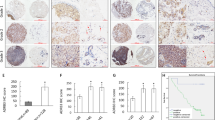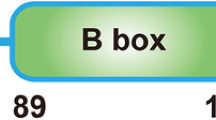Abstract
Myeloid-derived suppressor cells (MDSC) constitute the major cell population that regulates immune responses. They are known to accumulate in tumors, chronic inflammatory and autoimmune diseases. Previous data indicate that high mobility group box 1(HMGB1) facilitates MDSC differentiation from bone marrow, suppresses NK cells, CD4+ and CD8+ T cells and is involved in cancer development. However, it remains unclear what potential mechanisms of HMGB1 facilitate MDSC differentiation. In the present work, we clearly demonstrate that HMGB1 secreted by cancer cells is N-glycosylated at Asn37, which facilitates monocytic (M)-MDSC differentiation from bone marrow via the p38/NFκB/Erk1/2 pathway and also contributes to conversion of monocytes into MDSC-like cells; HMGB1 blockade by a monoclonal antibody against the HMGB1 B box obviously reduced the accumulation of M-MDSC in tumor-bearing mice, delaying tumor growth and development; additionally, MDSC expansion and HMGB1 up-regulation were also found in breast cancer patients. All these data indicate that HMGB1 might be a potential tumor immunotherapy target.





Similar content being viewed by others
Change history
24 January 2020
The Editor-in-Chief has retracted this article.
24 January 2020
The Editor-in-Chief has retracted this article.
Abbreviations
- Arg-1:
-
Arginase-1
- bio-HMGB1:
-
HMGB1 purify from the MCF-7 cell culturing (FBS free) supernatant
- ECL:
-
Electrochemiluminescence
- EP:
-
Ethyl pyruvate
- GAPDH:
-
Glyceraldehyde 3-phosphate dehydrogenase
- G-MDSC:
-
Granulocytic-MDSC
- HMGB1:
-
High mobility group box 1
- IMCs:
-
Immature myeloid cells
- iNOS:
-
Inducible nitric oxide synthase
- LAL:
-
Limulus amebocyte lysate
- mAb:
-
Monoclonal antibody
- MCF-7:
-
Human breast cancer cell line
- M-MDSC:
-
Monocytic-MDSC
- PNGase:
-
Peptide N-glycosidase
- PVDF:
-
Polyvinylidene difluoride
- RAGE:
-
Advanced glycation end-products
- rHMGB1:
-
Recombinant HMGB1
- S-A:
-
MCF-7 cell culturing supernatant anti-HMGB1 B box mAb
- SD:
-
Standard deviation
- S–E:
-
MCF-7 cell culturing supernatant with EP
References
Meirow Y, Kanterman J, Baniyash M (2015) Paving the road to tumor development and spreading: myeloid-derived suppressor cells are ruling the fate. Front Immunol 6:523. doi:10.3389/fimmu.2015.00523
Gabrilovich DI, Nagaraj S (2009) Myeloid-derived suppressor cells as regulators of the immune system. Nat Rev Immunol 9(3):162–174. doi:10.1038/nri2506
Movahedi K, Guilliams M, Van den Bossche J, Van den Bergh R, Gysemans C, Beschin A, De Baetselier P, Van Ginderachter JA (2008) Identification of discrete tumor-induced myeloid-derived suppressor cell subpopulations with distinct T cell-suppressive activity. Blood 111(8):4233–4244. doi:10.1182/blood-2007-07-099226
Almand B, Clark JI, Nikitina E, van Beynen J, English NR, Knight SC, Carbone DP, Gabrilovich DI (2001) Increased production of immature myeloid cells in cancer patients: a mechanism of immunosuppression in cancer. J Immunol 166(1):678–689
Sade-Feldman M, Kanterman J, Ish-Shalom E, Elnekave M, Horwitz E, Baniyash M (2013) Tumor necrosis factor-alpha blocks differentiation and enhances suppressive activity of immature myeloid cells during chronic inflammation. Immunity 38(3):541–554. doi:10.1016/j.immuni.2013.02.007
Zhan X, Fang Y, Hu S, Wu Y, Yang K, Liao C, Zhang Y, Huang X, Wu M (2015) IFN-gamma differentially regulates subsets of Gr-1(+) CD11b(+) myeloid cells in chronic inflammation. Mol Immunol 66(2):451–462. doi:10.1016/j.molimm.2015.05.011
Draghiciu O, Lubbers J, Nijman HW, Daemen T (2015) Myeloid derived suppressor cells—an overview of combat strategies to increase immunotherapy efficacy. Oncoimmunology 4(1):e954829. doi:10.4161/21624011.2014.954829
Shvedova AA, Kisin ER, Yanamala N, Tkach AV, Gutkin DW, Star A, Shurin GV, Kagan VE, Shurin MR (2015) MDSC and TGFbeta are required for facilitation of tumor growth in the lungs of mice exposed to carbon nanotubes. Cancer Res 75(8):1615–1623. doi:10.1158/0008-5472.CAN-14-2376
Sims GP, Rowe DC, Rietdijk ST, Herbst R, Coyle AJ (2010) HMGB1 and RAGE in inflammation and cancer. Annu Rev Immunol 28:367–388. doi:10.1146/annurev.immunol.021908.132603
Bianchi ME, Manfredi A (2004) Chromatin and cell death. Biochim Biophys Acta 1677(1–3):181–186. doi:10.1016/j.bbaexp.2003.10.017
Dumitriu IE, Baruah P, Manfredi AA, Bianchi ME, Rovere-Querini P (2005) HMGB1: guiding immunity from within. Trends Immunol 26(7):381–387. doi:10.1016/j.it.2005.04.009
Lotze MT, Tracey KJ (2005) High-mobility group box 1 protein (HMGB1): nuclear weapon in the immune arsenal. Nat Rev Immunol 5(4):331–342. doi:10.1038/nri1594
Muller S, Scaffidi P, Degryse B, Bonaldi T, Ronfani L, Agresti A, Beltrame M, Bianchi ME (2001) New EMBO members’ review: the double life of HMGB1 chromatin protein: architectural factor and extracellular signal. EMBO J 20(16):4337–4340. doi:10.1093/emboj/20.16.4337
Guo ZS, Liu Z, Bartlett DL, Tang D, Lotze MT (2013) Life after death: targeting high mobility group box 1 in emergent cancer therapies. Am J Cancer Res 3(1):1–20
Ladoire S, Enot D, Senovilla L, Ghiringhelli F, Poirier-Colame V, Chaba K, Semeraro M, Chaix M, Penault-Llorca F, Arnould L, Poillot ML, Arveux P, Delaloge S, Andre F, Zitvogel L, Kroemer G (2016) The presence of LC3B puncta and HMGB1 expression in malignant cells correlate with the immune infiltrate in breast cancer. Autophagy 12(5):864–875. doi:10.1080/15548627.2016.1154244
Ishiguro H, Nakaigawa N, Miyoshi Y, Fujinami K, Kubota Y, Uemura H (2005) Receptor for advanced glycation end products (RAGE) and its ligand, amphotericin are overexpressed and associated with prostate cancer development. Prostate 64(1):92–100. doi:10.1002/pros.20219
Jiang W, Wang Z, Li X, Fan X, Duan Y (2012) High-mobility group box 1 is associated with clinicopathologic features in patients with hepatocellular carcinoma. Pathol Oncol Res 18(2):293–298. doi:10.1007/s12253-011-9442-3
Akaike H, Kono K, Sugai H, Takahashi A, Mimura K, Kawaguchi Y, Fujii H (2007) Expression of high mobility group box chromosomal protein-1 (HMGB-1) in gastric cancer. Anticancer Res 27(1A):449–457
Liu PL, Tsai JR, Hwang JJ, Chou SH, Cheng YJ, Lin FY, Chen YL, Hung CY, Chen WC, Chen YH, Chong IW (2010) High-mobility group box 1-mediated matrix metalloproteinase-9 expression in non-small cell lung cancer contributes to tumor cell invasiveness. Am J Respir Cell Mol Biol 43(5):530–538. doi:10.1165/rcmb.2009-0269OC
Parker KH, Sinha P, Horn LA, Clements VK, Yang H, Li J, Tracey KJ, Ostrand-Rosenberg S (2014) HMGB1 enhances immune suppression by facilitating the differentiation and suppressive activity of myeloid-derived suppressor cells. Cancer Res 74(20):5723–5733. doi:10.1158/0008-5472.CAN-13-2347
Su Z, Sun C, Zhou C, Liu Y, Zhu H, Sandoghchian S, Zheng D, Peng T, Zhang Y, Jiao Z, Wang S, Xu H (2011) HMGB1 blockade attenuates experimental autoimmune myocarditis and suppresses Th17-cell expansion. Eur J Immunol 41(12):3586–3595. doi:10.1002/eji.201141879
Mace TA, Ameen Z, Collins A, Wojcik S, Mair M, Young GS, Fuchs JR, Eubank TD, Frankel WL, Bekaii-Saab T, Bloomston M, Lesinski GB (2013) Pancreatic cancer-associated stellate cells promote differentiation of myeloid-derived suppressor cells in a STAT3-dependent manner. Cancer Res 73(10):3007–3018. doi:10.1158/0008-5472.CAN-12-4601
Waight JD, Netherby C, Hensen ML, Miller A, Hu Q, Liu S, Bogner PN, Farren MR, Lee KP, Liu K, Abrams SI (2013) Myeloid-derived suppressor cell development is regulated by a STAT/IRF-8 axis. J Clin Investig 123(10):4464–4478. doi:10.1172/JCI68189
Tian J, Ma J, Ma K, Guo H, Baidoo SE, Zhang Y, Yan J, Lu L, Xu H, Wang S (2013) β-Glucan enhances antitumor immune responses by regulating differentiation and function of monocytic myeloid-derived suppressor cells. Eur J Immunol 43(5):1220–1230. doi:10.1002/eji.201242841
Mao Y, Sarhan D, Steven A, Seliger B, Kiessling R, Lundqvist A (2014) Inhibition of tumor-derived prostaglandin-e2 blocks the induction of myeloid-derived suppressor cells and recovers natural killer cell activity. Clin Cancer Res 20(15):4096–4106. doi:10.1158/1078-0432.CCR-14-0635
Obermajer N, Muthuswamy R, Lesnock J, Edwards RP, Kalinski P (2011) Positive feedback between PGE2 and COX2 redirects the differentiation of human dendritic cells toward stable myeloid-derived suppressor cells. Blood 118(20):5498–5505. doi:10.1182/blood-2011-07-365825
Albeituni SH, Ding C, Yan J (2013) Hampering immune suppressors: therapeutic targeting of myeloid-derived suppressor cells in cancer. Cancer J 19(6):490–501. doi:10.1097/PPO.0000000000000006
Baniyash M, Sade-Feldman M, Kanterman J (2014) Chronic inflammation and cancer: suppressing the suppressors. Cancer Immunol Immunother 63(1):11–20. doi:10.1007/s00262-013-1468-9
Diener KR, Al-Dasooqi N, Lousberg EL, Hayball JD (2013) The multifunctional alarmin HMGB1 with roles in the pathophysiology of sepsis and cancer. Immunol Cell Biol 91(7):443–450. doi:10.1038/icb.2013.25
Magna M, Pisetsky DS (2014) The role of HMGB1 in the pathogenesis of inflammatory and autoimmune diseases. Mol Med 20:138–146. doi:10.2119/molmed.2013.00164
Kang R, Zhang Q, Zeh HJ 3rd, Lotze MT, Tang D (2013) HMGB1 in cancer: good, bad, or both? Clin Cancer Res 19(15):4046–4057. doi:10.1158/1078-0432.CCR-13-0495
Harris HE, Andersson U, Pisetsky DS (2012) HMGB1: a multifunctional alarmin driving autoimmune and inflammatory disease. Nat Rev Rheumatol 8(4):195–202. doi:10.1038/nrrheum.2011.222
Su Z, Zhang P, Yu Y, Lu H, Liu Y, Ni P, Su X, Wang D, Wang J, Shen H, Xu W, Xu H (2016) HMGB1 facilitated macrophage reprogramming towards a proinflammatory M1-like phenotype in experimental autoimmune myocarditis development. Sci Rep 6:21884. doi:10.1038/srep21884
Antoine DJ, Harris HE, Andersson U, Tracey KJ, Bianchi ME (2014) A systematic nomenclature for the redox states of high mobility group box (HMGB) proteins. Mol Med 20:135–137. doi:10.2119/molmed.2014.00022
Janko C, Filipovic M, Munoz LE, Schorn C, Schett G, Ivanovic-Burmazovic I, Herrmann M (2014) Redox modulation of HMGB1-related signaling. Antioxid Redox Signal 20(7):1075–1085. doi:10.1089/ars.2013.5179
Hori O, Brett J, Slattery T, Cao R, Zhang J, Chen JX, Nagashima M, Lundh ER, Vijay S, Nitecki D et al (1995) The receptor for advanced glycation end products (RAGE) is a cellular binding site for amphoterin. Mediation of neurite outgrowth and co-expression of rage and amphoterin in the developing nervous system. J Biol Chem 270(43):25752–25761
Ivanov S, Dragoi AM, Wang X, Dallacosta C, Louten J, Musco G, Sitia G, Yap GS, Wan Y, Biron CA, Bianchi ME, Wang H, Chu WM (2007) A novel role for HMGB1 in TLR9-mediated inflammatory responses to CpG-DNA. Blood 110(6):1970–1981. doi:10.1182/blood-2006-09-044776
Park JS, Svetkauskaite D, He Q, Kim JY, Strassheim D, Ishizaka A, Abraham E (2004) Involvement of toll-like receptors 2 and 4 in cellular activation by high mobility group box 1 protein. J Biol Chem 279(9):7370–7377. doi:10.1074/jbc.M306793200
Chen GY, Tang J, Zheng P, Liu Y (2009) CD24 and Siglec-10 selectively repress tissue damage-induced immune responses. Science 323(5922):1722–1725. doi:10.1126/science.1168988
Acknowledgements
This work was supported by the National Natural Science Foundation of China (Grant Nos. 81370084, 81502663), the Social Development Foundation of Jiangsu Province (Grant No. BE2015668). The six talent peaks project in Jiangsu Province (2013-WSN-002, 2015-WSN-005); the maternal and child project in Jiangsu Province (F201511). We thank Huaxi Xu and the International Science Editing Company for editing and proofreading the manuscript.
Author information
Authors and Affiliations
Corresponding author
Ethics declarations
Conflict of interest
The authors declare that they have no conflict of interest.
Additional information
The Editor-in-Chief has retracted this article [1] because a number of the images in Figures 4a and 4c, appear to have been duplicated then either rotated, cropped or stretched to make them appear to be different tumors. The Editor-in-Chief no longer has confidence in the results and conclusions presented in this article. Jia Wang agrees with this retraction. Seidu A. Richard does not agree with this retraction. Zhaoliang Su, Ping Ni, Peng She, Yueqin Liu, Wenlin Xu and Haitao Zhu have not responded to correspondence about this retraction.
[1] Zhaoliang Su, Ping Ni, Peng She, Yueqin Liu, Seidu A. Richard,Wenlin Xu, Haitao Zhu, Jia Wang. Bio-HMGB1 from breast cancer contributes to M-MDSC differentiation from bone marrow progenitor cells and facilitates conversion of monocytes into MDSC-like cells. Cancer Immunol Immunother 2017 66(3): 391-401, doi: 10.1007/s00262-016-1942-2.
Electronic supplementary material
Below is the link to the electronic supplementary material.
About this article
Cite this article
Su, Z., Ni, P., She, P. et al. RETRACTED ARTICLE: Bio-HMGB1 from breast cancer contributes to M-MDSC differentiation from bone marrow progenitor cells and facilitates conversion of monocytes into MDSC-like cells. Cancer Immunol Immunother 66, 391–401 (2017). https://doi.org/10.1007/s00262-016-1942-2
Received:
Accepted:
Published:
Issue Date:
DOI: https://doi.org/10.1007/s00262-016-1942-2




